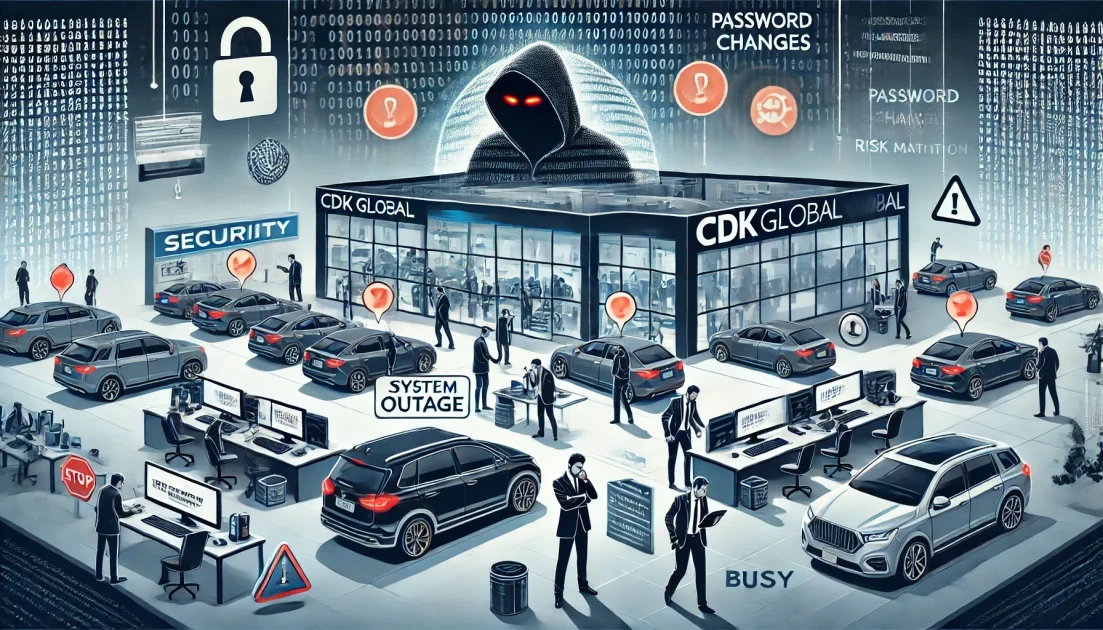The Hidden Dangers of CDK Cyber Attacks and How to Fortify Your Business

In today’s fast-paced digital world, businesses of all sizes rely on technology to manage operations, serve customers, and store sensitive data. However, with the increasing dependency on technology comes a rising threat: cyberattacks. One such type of attack is a CDK cyber attack, which can have devastating consequences for companies in various industries. This post will provide an in-depth look at CDK cyber attacks, their potential impact on businesses, and practical steps for safeguarding your organization against these threats.
What Is a CDK Cyber Attack?
A CDK cyber attack targets the technology infrastructure of businesses that use CDK Global software. CDK Global is a major provider of software solutions used by automotive dealerships worldwide to manage their operations, inventory, customer relationships, and more. The data stored and managed through these systems are highly valuable, making it a lucrative target for cybercriminals.
These attacks are often orchestrated by hackers with the intent to:
- Steal sensitive business information, such as customer data.
- Disrupt business operations by causing system downtime.
- Demand ransom in exchange for restoring data access (ransomware).
- Damage a company’s reputation, leading to loss of trust and customers.
How CDK Cyber Attacks Unfold
Cybercriminals utilize a variety of methods to launch CDK cyber attacks. Some common strategies include:
1. Phishing
Phishing remains one of the most common forms of cyberattack, not just for CDK systems but for businesses across all sectors. In a phishing attack, employees or administrators of CDK systems may receive fraudulent emails designed to trick them into clicking malicious links or downloading harmful attachments. These emails are often crafted to look like legitimate communication from trusted sources, including partners or internal departments.
Once the victim interacts with the malicious link, the hacker can gain unauthorized access to the system, potentially leading to a full-scale breach.
2. Ransomware Attacks
In a ransomware attack, hackers infiltrate the CDK system and encrypt critical data, rendering it inaccessible to the business until a ransom is paid. Businesses that rely heavily on their CDK systems for daily operations are particularly vulnerable to these attacks. If they cannot access customer records, inventory management tools, or other essential data, it can bring their entire operation to a halt.
Ransom demands can range from thousands to millions of dollars, and even if a company pays the ransom, there is no guarantee that the criminals will restore full access to the data.
3. Malware Injection
Malware is another method frequently employed in CDK cyber attacks. Hackers use malware (malicious software) to corrupt, steal, or erase data stored within the system. This can be executed through compromised websites, software vulnerabilities, or malicious downloads. The malware can stay dormant in the system until triggered, making it a long-term threat to business operations.
4. Exploiting Software Vulnerabilities
Every piece of software has potential weaknesses, and CDK Global software is no exception. Cybercriminals actively look for vulnerabilities in these systems that they can exploit. This can involve outdated software versions, unpatched bugs, or weaknesses in third-party integrations that connect to the CDK platform. By exploiting these weaknesses, attackers can gain unauthorized access to sensitive areas of the system.
The Consequences of a CDK Cyber Attack
The impact of a CDK cyber attack can be wide-reaching, affecting multiple aspects of a business’s operations. Let’s break down the potential consequences:
1. Financial Loss
Cyberattacks can result in significant financial damage. Beyond the immediate costs associated with paying a ransom or restoring compromised systems, businesses often face indirect costs. These may include lost revenue from downtime, penalties for failing to protect customer data, and legal fees associated with addressing breaches. For small and medium-sized businesses, these costs can be devastating.
2. Reputational Damage
In the age of information, trust is a valuable currency. When a business falls victim to a cyberattack, especially one involving sensitive customer data, it can suffer a loss of trust among its customers and partners. Even if the business manages to recover from the attack, the damage to its reputation can linger, leading to a long-term loss of business.
3. Operational Disruption
For companies that rely heavily on CDK Global software to manage their day-to-day operations, any disruption to the system can lead to significant downtime. This downtime affects everything from inventory management to customer relationship management. Extended outages can cause delays in service, missed opportunities, and frustrated customers.
4. Legal and Regulatory Consequences
Depending on the jurisdiction in which a business operates, there may be legal and regulatory repercussions for failing to protect customer data adequately. This can result in fines, lawsuits, or even loss of licenses. Businesses in sectors like automotive sales, where customer privacy is of utmost importance, are particularly vulnerable to legal action following a breach.
How to Protect Your Business from CDK Cyber Attacks
Protecting your business from a CDK cyber attack requires a proactive approach to cybersecurity. Here are several key strategies to reduce your risk and safeguard your operations:
1. Employee Training
One of the simplest yet most effective ways to prevent cyberattacks is through employee education. Phishing schemes and social engineering tactics often target employees, so it’s essential that your team recognizes potential threats. Regular cybersecurity training should include:
- How to identify suspicious emails and avoid clicking on unfamiliar links.
- The importance of reporting potential security threats to the IT department.
- Safe browsing habits and recognizing website security warnings.
Training should be an ongoing process to keep up with evolving cyberattack tactics.
2. Implement Strong Password Policies
Weak passwords are one of the most common ways attackers gain access to systems. Businesses should enforce strong password policies, requiring employees to use complex combinations of letters, numbers, and symbols. Additionally, passwords should be changed regularly, and multi-factor authentication (MFA) should be used wherever possible.
MFA adds an extra layer of security by requiring users to verify their identity through another method, such as a code sent to their phone or email.
3. Regular Software Updates and Patches
As mentioned earlier, software vulnerabilities are often the entry point for cyberattacks. Ensuring that your CDK Global software and all other associated systems are up to date is essential. Software updates often include security patches designed to fix known vulnerabilities. Make it a priority to:
- Regularly check for and install updates from CDK Global.
- Update any third-party tools that integrate with your CDK systems.
- Monitor security alerts from CDK Global and other software providers for new risks.
4. Network Segmentation
Segmenting your network is an effective way to limit the damage that can be done if a breach occurs. Network segmentation involves dividing your IT infrastructure into smaller, isolated networks. If one segment is compromised, the attack cannot easily spread to other areas of your business.
For example, a dealership might segment its customer relationship data from its financial records, so that a breach in one area does not expose all sensitive information.
5. Data Backup and Recovery
Ransomware attacks are particularly damaging because they hold your data hostage. However, a robust data backup and recovery system can mitigate the effects of such an attack. Regularly back up your critical data and ensure that those backups are stored in a secure, offsite location. Additionally, test your recovery plan to make sure your business can resume operations quickly if an attack occurs.
6. Invest in Cybersecurity Tools
There are various cybersecurity tools available that can help prevent, detect, and respond to cyberattacks. Some key tools to consider include:
- Firewalls: A firewall acts as a barrier between your internal network and the outside world, filtering traffic to block malicious activity.
- Antivirus and Anti-Malware Software: These programs detect and remove harmful software from your system.
- Intrusion Detection and Prevention Systems (IDPS): IDPS can monitor your network for suspicious activity and take action to prevent breaches.
By investing in the right cybersecurity tools, you can strengthen your defense against CDK cyber attacks and other threats.
How to Respond If You’ve Been Targeted
If your business has already fallen victim to a CDK cyber attack, it’s essential to act quickly to minimize the damage. Here are the immediate steps to take:
1. Contain the Breach
First and foremost, isolate the affected systems to prevent the attack from spreading. This may involve disconnecting infected machines from the network or shutting down certain services temporarily. The goal is to stop the attacker from causing further damage while your team works on a response.
2. Notify Relevant Parties
Once the attack has been contained, it’s important to notify both internal stakeholders and external parties such as customers, partners, and regulatory bodies. Be transparent about what happened and what steps you are taking to address the issue.
3. Work with Cybersecurity Experts
In the aftermath of an attack, it’s often necessary to bring in cybersecurity experts to assess the full scope of the breach. They can help identify how the attack occurred, what data was compromised, and how to prevent future incidents. It’s also important to work with legal counsel to ensure compliance with any applicable data breach reporting laws.
4. Review and Strengthen Security Protocols
After the breach has been resolved, conduct a thorough review of your security protocols. Identify any weaknesses that allowed the attack to occur and implement new measures to prevent future breaches. This may involve updating your software, strengthening your access controls, or investing in more robust security tools.
Conclusion
A CDK cyber attack is a serious threat that can cause significant harm to businesses relying on CDK Global software. From financial losses to reputational damage, the consequences of such an attack can be long-lasting. However, by taking proactive measures, such as employee training, software updates, and investing in cybersecurity tools, businesses can significantly reduce their risk of falling victim to cyber threats.
If you believe your business could benefit from enhanced cybersecurity, consider partnering with professionals in the field. Their expertise can help you develop a robust cybersecurity strategy tailored to your specific needs, ensuring that your organization is better protected against the ever-evolving landscape of cyber threats.




